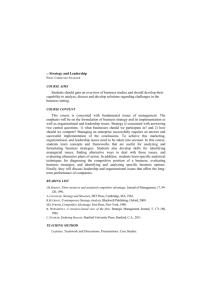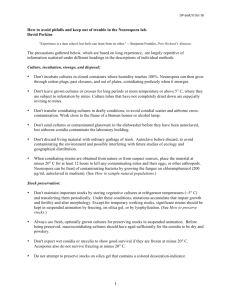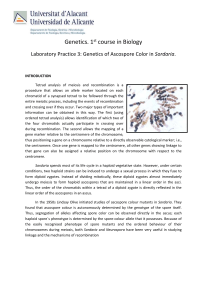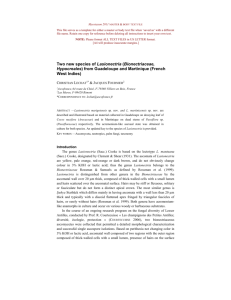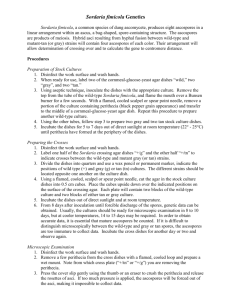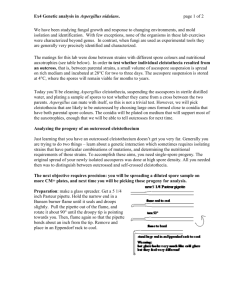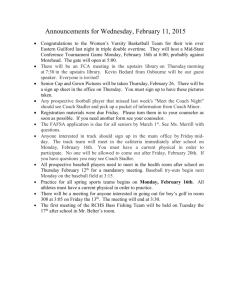Dichotomous key to European species of Daldinia
advertisement
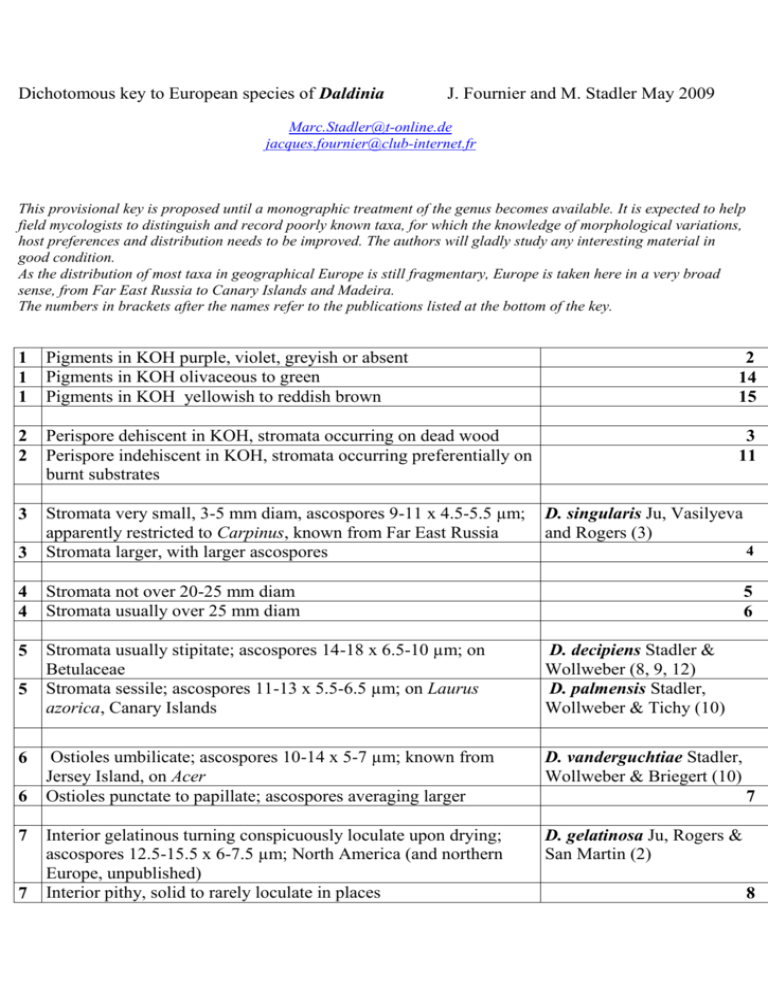
Dichotomous key to European species of Daldinia J. Fournier and M. Stadler May 2009 Marc.Stadler@t-online.de jacques.fournier@club-internet.fr This provisional key is proposed until a monographic treatment of the genus becomes available. It is expected to help field mycologists to distinguish and record poorly known taxa, for which the knowledge of morphological variations, host preferences and distribution needs to be improved. The authors will gladly study any interesting material in good condition. As the distribution of most taxa in geographical Europe is still fragmentary, Europe is taken here in a very broad sense, from Far East Russia to Canary Islands and Madeira. The numbers in brackets after the names refer to the publications listed at the bottom of the key. 1 1 1 Pigments in KOH purple, violet, greyish or absent Pigments in KOH olivaceous to green Pigments in KOH yellowish to reddish brown 2 14 15 2 2 Perispore dehiscent in KOH, stromata occurring on dead wood Perispore indehiscent in KOH, stromata occurring preferentially on burnt substrates 3 11 3 3 Stromata very small, 3-5 mm diam, ascospores 9-11 x 4.5-5.5 µm; apparently restricted to Carpinus, known from Far East Russia Stromata larger, with larger ascospores 4 4 Stromata not over 20-25 mm diam Stromata usually over 25 mm diam 5 Stromata usually stipitate; ascospores 14-18 x 6.5-10 µm; on Betulaceae Stromata sessile; ascospores 11-13 x 5.5-6.5 µm; on Laurus azorica, Canary Islands D. decipiens Stadler & Wollweber (8, 9, 12) D. palmensis Stadler, Wollweber & Tichy (10) Ostioles umbilicate; ascospores 10-14 x 5-7 µm; known from Jersey Island, on Acer Ostioles punctate to papillate; ascospores averaging larger D. vanderguchtiae Stadler, Wollweber & Briegert (10) Interior gelatinous turning conspicuously loculate upon drying; ascospores 12.5-15.5 x 6-7.5 µm; North America (and northern Europe, unpublished) Interior pithy, solid to rarely loculate in places D. gelatinosa Ju, Rogers & San Martin (2) 5 6 6 7 7 D. singularis Ju, Vasilyeva and Rogers (3) 4 5 6 7 8 8 8 Stromatal surface reticulate-cracked Stromatal surface not reticulate-cracked 9 Ostioles finely papillate; ascospores 13-17 x 6-7.5 µm; plurivorous, D. concentrica (Bolt.: Fr.) frequent on Fraxinus, temperate Europe Ces. & De Not. (4, 5, 6, 9, 10, 12) Ostioles punctate; ascospores 14-17 x 6-8 µm; on Quercus suber D. martinii Stadler, and Carya olivaeformis, Sicily. Venturella & Wollweber (10) 9 9 10 10 Ostioles papillate ; ascospores 12.5-16.5 x 6.5-7.5 µm; on Betulaceae, in Alps and Central Europe D. petriniae Ju, Rogers & San Martin [2, 4 (as D. occidentalis), 6, 9, 12] D. raimundii Stadler, 10 Ostioles punctate ; ascospores 12-14 x 6-7 µm ; on Quercus ilex, known from Sicily and Ile de Ré Venturella & Wollweber (10) 10 Ostioles punctate ; ascospores 13-16 x 5-7 µm ; on Ocotea foetens, D. macaronesica Stadler, Canary Islands, Madeira Wollweber & Castro (10) 11 Ascospores 8-11 x 4-5.5 µm; most often on burnt Ulex D. caldariorum Henn. (2, 6, 9, 12) 11 Ascospores larger 12 12 Interior gelatinous, turning loculate, white, with zonation often inconspicuous at maturity; ascospores 11.5-15.5 x 6.5-9 µm, on various burnt woody substrates including Ulex, north temperate to subtropical 12 Interior pithy to fibrous, solid, grey brown, weakly loculate, with conspicuous zonation; on burnt wood D. fissa Lloyd (2, 3, 4, 6, 9, 12) 13 Ascospores 11-14 x 6-8 µm ; Scandinavia, Germany and UK. D. loculata (Lév.) Sacc. (1, 2, 4, 6, 9, 12) D. loculatoides Wollweber & Stadler (11) 13 Ascospores 15-19 x 7-9 µm; Canada, UK, Czech Republic 14 Surface of young stromata with conspicuous brown polygonal scales; pigments in KOH greenish; ascospores 12-18 x 6-7.5 µm; on Betula 14 Surface lacking polygonal scales; pigments in KOH olivaceous, at times with a purplish shade; ascospores 12.5-16.5 x 6.5-7.5 µm; on Betulaceae 13 D. lloydii Ju, Rogers & San Martin (2, 6, 9, 12) D. petriniae Ju, Rogers & San Martin [2, 4(as D. occidentalis), 6, 9, 12] 15 Stromata usually on a short stout stipe, rarely over 2 cm diam; ascospores 12-16 x 5.5-7.5 µm; cosmopolitan in warm temperate areas 15 Stromata sessile, larger; ascospores 13-17 x 6.5-8 µm ; known from Spanish Pyrénées and Central Europe D. childiae Rogers & Ju (5, 6, 9, 12) D. pyrenaica Stadler & Wollweber (7, 9, 12) References 1 Johannesson H, Laessøe T, Stenlid J (2000): Molecular and morphological investigation of the genus Daldinia in Northern Europe. Mycological Research 104: 275–280. 2 Ju Y–M, Rogers JD, San Martín F (1997). A revision of the genus Daldinia. Mycotaxon 61: 243– 293. 3 Ju Y–M, Vasilyeva L & Rogers JD (1997). Daldinia singularis sp nov from eastern Russia and notes on some other taxa. Mycotaxon 71: 405-412. 4 Petrini LE & Müller E (1986). Haupt– und Nebenfruchtformen europäischer Hypoxylon–Arten (Xylariaceae, Sphaeriales) und verwandter Pilze. Mycologia Helvetica 1: 501–627. 5 Rogers JD, Ju Y–M, Watling R, Whalley AJS (1999). A reinterpretation of Daldinia concentrica based upon a recently discovered specimen. Mycotaxon 72: 507–520. 6 Stadler M, Wollweber H, Mühlbauer A, Henkel T, Asakawa Y, Hashimoto T, Rogers JD, Ju Y–M, Wetzstein H–G, Tichy H–V (2001a) Secondary metabolite profiles, genetic fingerprints and taxonomy of Daldinia and allies. Mycotaxon 77: 379–429. 7 Stadler M, Baumgartner M, Wollweber H (2001c). Three new Daldinia species with yellowish stromatal pigments. Mycotaxon 80: 179–196. 8 Stadler M, Baumgartner M, Wollweber H, Rogers JD, Ju Y-M (2001d). Daldinia decipiens sp. nov. and notes on some other European Daldinia spp. inhabiting Betulaceae. Mycotaxon 80: 167177. 9 Stadler M, Baumgartner M, Ide K, Popp A. Wollweber H (2002). Importance of ascospore ornamentation in the taxonomy of Daldinia. Mycological Progress 1: 31–42. 10 Stadler M, Wollweber H, Jäger W, Briegert M, Venturella G, Castro JM & Tichy H–V (2004a) Cryptic species related to Daldinia concentrica and D. eschscholzii, with notes on D. bakeri. Mycological Research 108: 257–273. 11 Stadler M, Læssøe T, Simpson J & Wollweber H (2004b) A survey of Daldinia species with large ascospores. Mycological Research 108: 1025-1041. 12 Wollweber H, Stadler M (2001) Zur Kenntnis der Gattung Daldinia in Deutschland und Europa. Zeitschrift für Mykologie 67: 3–51.
